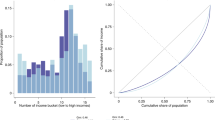Abstract
A significant positive relationship between income inequality and homicide rates has been found in a large number of cross-sectional studies and a few longitudinal analyses; a theoretically interesting interaction effect between income inequality and social welfare has also been found. For the most part researchers have been willing to use generous quality criteria in collecting income-distribution data, to maximize sample size and thereby enhance statistical power and representativeness. In the present paper we use a recently developed data set with explicit quality ratings for the income-distribution data, which permits systematic assessment of the consequences of relying on income-distribution measures of varying quality in examining the inequality-homicide relationship. Our analyses reveal that the income inequality-homicide relationship is remarkably robust in cross-sectional analyses. Regardless of the quality of income-distribution data, we observe significant positive effects of the Gini coefficient on homicide rates in cross-sectional multivariate models. Consistent results are also observed when an interaction term for income inequality and decommodification is examined. The results of longitudinal analyses differ; we observe a significant positive effect of changes in inequality on changes in homicide rates only when income-distribution measures of low quality are used.
Similar content being viewed by others
REFERENCES
Bennett, R. R., and Lynch, J. P. (1990). Does difference make a difference? Comparing crossnational crime indicators. Criminology 28: 153-181.
Bennett, R. R. (1991a). Development and crime: A cross-national, time-series analysis of competing models. Sociol. Q. 32: 343-363.
Bennett, R. R. (1991b). Routine activities: A cross-national assessment of a criminological perspective. Soc. Forces 70: 147-163.
Blau, P. M., and Blau, J. R. (1982). The cost of inequality: Metropolitan structure and criminal violence. Am. Sociol. Rev. 47: 114-129.
Bollen, K. A. (1989). Structural Equations with Latent Variables, Wiley, New York.
Deininger, K., and Squire, L. (1996). A new data set measuring income inequality. World Bank Econ. Rev. 10: 565-591.
Deininger, K., and Squire, L. (1998). New ways of looking at old issues: Inequality and growth. J. Dev. Econ. 57: 259-287.
Esping-Andersen, G. (1990). The Three Worlds of Welfare Capitalism. Princeton University Press, Princeton, N.J.
Fajnzylber, P., Lederman, D., and Loayza, N. (1998). Determinants of Crime Rates in Latin America and the World: An Empirical Assessment, World Bank, Washington, D.C.
Forbes, K. J. (2000). A reassessment of the relationship between inequality and growth. Am. Econ. Rev. 90: 869-887.
Gartner, R. (1990). The victims of homicide: A temporal and cross-national comparison. Am. Sociol. Rev. 55: 92-106.
Gartner, R. (1995). Methodological issues in cross-cultural large-survey research on violence. In Ruback, R. B., and Weiner, N. A. (eds.), Interpersonal Violent Behaviors: Social and Cultural Aspects, Springer, New York, pp. 7-24.
Gujarati, D. N. (1995). Basic Econometrics, McGraw-Hill, New York.
Huang, W. S. W., and Wellford, C. F. (1989). Assessing indicators of crime among international data series. Crim. Justice Policy Rev. 3: 28-47.
International Labour Office (1992). The Cost of Social Security. International Labour Office.
Jaccard, J., Turrisi, R., and Wan, C. K. (1990). Interaction Effects in Multiple Regression, Sage, Newbury Park, CA.
Kalish, C. B. (1988). International Crime Rates, U.S. Department of Justice, Washington, D.C.
Krahn, H., Hartnagel, T. F., and Gartrell, J. W. (1986). Income inequality and homicide rates: cross-national data and criminological theories. Criminology 24: 269-295.
LaFree, G. (1999). A summary and review of cross-national comparative studies of homicide. In Smith, M. D., and Zahn, M. A. (eds.), Homicide: A Sourcebook of Social Research, Sage, Thousand Oaks, CA., pp. 125-145.
LaFree, G., and Drass, K. A. (1996). The effect of changes in intraracial income inequality and educational attainment of changes in arrest rates for African Americans and Whites, 1957-1990. Am. Sociol. Rev. 61: 614-634.
Lederman, D., Loayza, N., and Menéndez, A. M. (2000). Violent crime: Does social capital matter? In International Conference on Crime and Violence: Causes and Policy Reponses. Sponsored by the Office of the Chief Economist for Latin America and the Caribbean, World Bank, and the Economics Department of the University of the Andes. Bogota, Colombia, May 4-5.
Messner, S. F. (1992). Exploring the consequences of erratic data reporting for cross-national research on homicide. J. Quant. Criminol. 8: 155-173.
Messner, S. F. (forthcoming). Understanding cross-national variation in criminal violence. In Heitmeyer, W., and Hagan, J. (eds.), Handbook of Research on Violence, Westview Press, New York.
Messner, S. F., and Rosenfeld, R. (1997). Political restraint of the market and levels of criminal homicide: A cross-national application of institutional-anomie theory. Soc. Forces 75: 1393-1426.
Neapolitan, J. L. (1994). Cross-national variation in homicides: The case of Latin America. Int. Crim. Justice Rev. 4: 4-22.
Neapolitan, J. L. (1996). Cross-national crime data: Some unaddressed problems. J. Crime Just. 19: 95-112.
Neapolitan, J. L. (1997). Cross-National Crime: A Research Review and Sourcebook, Greenwood Press, Westport, CT.
Newman, G., and Howard, G. J. (1999). Introduction: Data sources and their use. In Newman, G. (ed.), Global Report on Crime and Justice, Oxford University Press, New York, pp. 1-23.
Nisbett, R. A. (1966). The Sociological Tradition, Basic Books, New York.
Pampel, F. C., and Gartner, R. (1995). Age structure, socio-political institutions, and national homicide rates. Eur. Sociol. Rev. 11: 243-260.
Savolainen, J. (2000). Inequality, welfare state, and homicide: Further support for the institutional anomie theory. Criminology 38: 1021-1042.
Stack, S. (1984). Income inequality and property crime: A cross-national analysis of relative deprivation theory. Criminology 22: 229-257.
United Nations (2000a). UNU/WIDER-UNDP World Income Inequality Database, Version 1.0, 12 September 2000. Available on-line at: <http://www.wider.unu.edu/wiid/wiid.htm>
United Nations (2000b). UNU/WIDER-UNDP World Income Inequality Database, Version 1.0, 12 September 2000. User guide and data sources. Available on-line at: http:// www.wider.unu.edu/wiid/wiid.htm <http://www.wider.unu.edu/wiid/wiid.htm>
infonation.htm
World Bank (1998). 1998 World Development Indicators. Compact data disk distributed by the World Bank.
World Health Organization (various years). World Health Statistics Annual. World Health Organization.
Author information
Authors and Affiliations
Rights and permissions
About this article
Cite this article
Messner, S.F., Raffalovich, L.E. & Shrock, P. Reassessing the Cross-National Relationship Between Income Inequality and Homicide Rates: Implications of Data Quality Control in the Measurement of Income Distribution. Journal of Quantitative Criminology 18, 377–395 (2002). https://doi.org/10.1023/A:1021169610837
Issue Date:
DOI: https://doi.org/10.1023/A:1021169610837



